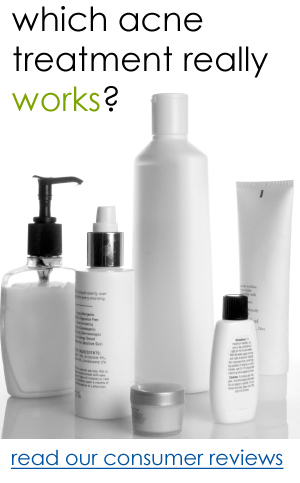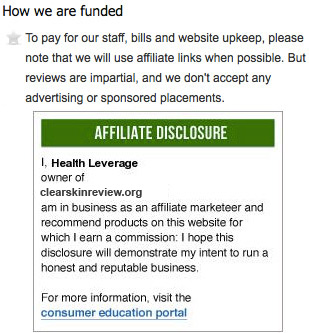What Acne Have You Got?
In every man and woman’s teenage years, it was almost inevitable that some form of blemish would befall their rough, oily, skin. The radical chemical changes that occur during puberty affect the skin so adversely; causing an overproduction of sebum and an opening of the skin’s pores. Combined with activities such as sports or eating vast amounts of junk food, this dirt and oil clogs the pores which causes a buildup of pus and sebaceous oil. Eventually, this would result in a red, bumpy, rash that could be accompanied by a white or black tip.
This is acne, and while for many it goes away after the awkward high school years, some are cursed with its presence long after. For these people, acne causes both insecurity and, depending on the acne, severe health issues.
Acne comes in a variety of forms, from isolated bumps to widespread “hot-zones”. Before determining which exact type of acne one suffers from, dermatologists break acne down into two basic categories.
Inflammatory-Acne in this category is usually widespread and tends to appear on the face, back, check, and shoulders. This acne can be painful and usually comes with blistering or pushing black or whiteheads.
Non-Inflammatory-This acne tends to be more isolated in small patches. The acne tends to be only be a cosmetic inconvenience and usually is not painful. Acne in this category does not reach the surface of the skin, making the area red instead of black or white.
After doctors determine whether the acne is or is not inflammatory, they then begin to refer to the various types of acne. They are the following:
Acne Vulgaris
Acne vulgaris is the most common form of acne, affecting about 96% of all teenagers at one point. Acne Vulgaris is normally mild, but also has a severe form. Symptoms from either are:
Mild Case-Mild acne vulgaris
This is only a mild cosmetic disfiguration. It is categorized many times by beginning as a red bump and then slowly resulting in a white or blackhead after enough sebum has accumulated. The trademark blemishes associated with mild vulgaris are:
Whitehead
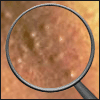
Pimple with a white cap that occurs just below the surface of the skin and is made of pus, sebum, dead skin, and usually is the quickest to remove.
Blackhead
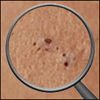
Pimple that has a dark cap which is due to partially clogged pores reaching the surface of the skin. The contact with oxygen causes the black color. Blackheads take longer to remove because they are fairly rooted.
Pustule/Papules
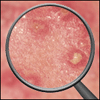
A red bump that sometimes contains a white dot (pustule). They are not meant to be popped and people are strongly advised not to try and pop them. This will only cause more scarring, and popped blood vessels which make it more visible.
Severe Case Acne Vulgaris
-This acne causes not only cosmetic imperfections but can also be extremely painful. Severe cases are also typically widespread, which makes the sufferer much more self-conscious about his/her skin. Two blemishes include:
Nodules
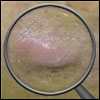
These cover a much wider surface area and is red with the shade depending on the proximity of sebum to the surface. Never attempt to pop these blemishes; the distance from the surface can cause extreme pain and attempting to pop it can result in scarring. Attempting to pop it can cause an imperfection to form behind the gland, which can cause flaring years later. Dermatologists normally shrink the blemish with cortisol injections.
Cysts
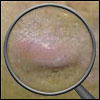
Like a nodule, cysts cover a large surface area except the white cap is perfectly visible. Do not attempt to remove this blemish either; although tempting, the opening is highly susceptible to infection and can become even more painful than before and can leave scars.
Acne Rosacea

This type of acne is known for its widespread red coloration that looks like blushing. It is found frequently in those of eastern European decent, where cold temperatures and fair skin cause the rosacea to become very visible. On the skin, it is normally bumpy, red, and can be irritated. If untreated, it can cause severe disfigurations on the nose, forehead, or cheeks. It’s more common in women, and is treated differently than acne.
Severe Forms of Acne
Acne Conglobata
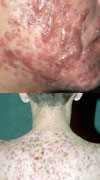
Also known as the most severe type of acne vulgaris, it is categorized by widespread lesions throughout the body with blackheads, red sores, and oozing in rare cases. The lesions are extremely painful, producing scars and burning sensations. Occurs mostly in males 18-30 years old.
Acne Fulminans
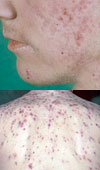
This is a more extreme case of acne conglobata in which the sores ooze and ulcerate. This acne also causes fever and joint pain.
Gram Negative Folliculitis
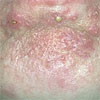
This is a bacterial infection of the skin, which develops from prolong anti-biotic treatment of acne vulgaris. It is a rare disorder, adding pustules and cysts throughout infected areas. It is difficult to determine the frequency and exact source of the complication so there are no noted prevention methods.
Pyoderma Faciale (Rosacea Fulminans)
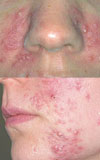
This is a very rapid forming acne, occurring in female ages 20-40. Victims will develop severe pustules, large nodules, and widespread pain but it is only restricted to the face. It can occur in both women who had a history of acne and women who never had severe cases. This acne can scar easily and although it lasts less than a year, it can cause very severe disfigurations.
Due to the aggressive nature of most of the aforementioned acne types, most dermatologists will prescribe strong corticosteroids to reduce inflammation and shut down sebaceous glands. Currently, the most effective medication is isotretinoin (Accutane) which can completely eradicate acne in a few months. Use caution: Accutane does have powerful side effects, including crohn’s disease, anemia, and severe birth defects.
